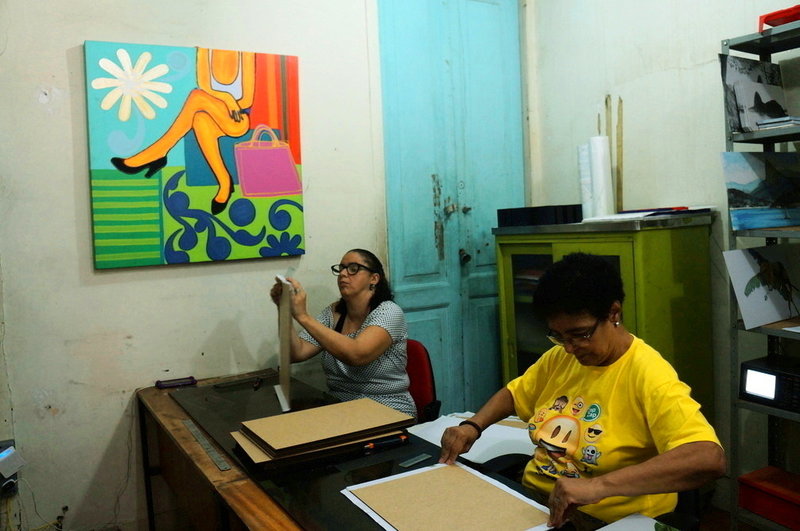
Tucked away in Rio’s bustling city centre is a remarkable organisation. To get there, I meet my Made In Rio de Janeiro tour guide, who steers me through the Saara Market, a famous outdoor market in the city’s downtown. The warren of stalls brims with clothes, Carnival fancy dress and endless gadgets before eventually opening out to a labyrinth of cobbled streets, flanked on either side with busy stores selling inexpensive merchandise. We drift to the edge of the street towards one of the small, aging townhouses and enter through a nondescript door that opens up to a long wooden staircase.
I have arrived at Tempo Objeto, a small company run by Lilian Sampaio, that specialises in producing souvenirs of Rio de Janeiro made on-site by a team of deaf and mute women. The studio is both a shop floor and workshop, where the keepsakes are displayed at the front and the women work at the back taking the images of local artists’ work and printing them onto placemats and coasters.
“We transform paintings,” Lilian explains. “I buy the image from local Brazilian artists. Then the girls print the picture, transform it digitally, put it into vinyl, and make the object. They have the skills for this. We are a team, the women are essential, this company would not exist without them.”

One of the workers, Carla, at work at Tempo Objeto | Photo by Sarah Brown
Tempo Objeto started in 2000 with Lilian and her business partner, Sandra, who also makes the souvenirs. There are currently two women working there full-time on a flexible contract and others who work on a sporadic basis. When the company began, Lilian decided to employ people who could be not only an asset to the company, but also people she could help. She called a local institute that specialises in assisting deaf and mute people and explained her idea. Soon after, Carla was hired, followed by another woman, Sueli. It’s clear that these women mean a lot to Lilian.
“The girls are very special, very patient, very willing,” she says. “They can’t hear or speak. They don’t use a hearing device and were born with this disability. They are very happy here, it gives them an income, they can buy their own things, have their own independence and lives.”
Watch to see what treasures you can find on a Made In tour!
My reason for visiting the workshop is to meet these very women. They sit at a large desk surrounded by striking images printed on thick paper. I watch them as they line up the paper against a ruler, slice the excess paper off and fix it to a piece of MDF wood. They seem focused on the task at hand, engaged in creating the perfect souvenir. My movement catches their eyes and they look up, greeting me with warm looks and wide smiles. I ask Lilian how she communicates with them, given she doesn’t use sign language.
“I have my own personal communication with them,” she says. “I have certain gestures that they understand and we’ve ended up developing our own code for work. Carla can lip read so it’s much easier and my partner speaks sign language. They speak among themselves in sign language but they also have their own unique gestures.”

“[Working here] gives them an income, they can buy their own things, have their own independence and lives.” | Photo by Sarah Brown
Lilian works directly with local artists, using the image of their artworks to print onto various souvenirs. The artists receive royalties from the images and the opportunity to expose their work to a larger audience. Many of the souvenirs are sold at the studio, whereas others are sold by the artists themselves. The paintings represent classic scenes from Rio de Janeiro as well as striking imagery of Brazilian nature and culture.

Unique souvenirs for a good cause | Photo by Sarah Brown
Lilian first sold images in a shop at the Museum of Fine Arts. After the shop closed, artists began to approach her, wanting to exhibit their work on her souvenirs. She started working closely with them and before long, she was selling touristic placemats in Copacabana Palace. Her emphasis has always been on creating local connections, seeking out local artists, local suppliers and local materials. I ask her what she thinks about tourists buying products produced within the region they are visiting.
“I think it’s important,” she says. “Look how many people are involved in my studio. When one person buys a coaster, they are paying royalty to a local artist, providing an income for their work, helping employees have financial independence, creating demand for local suppliers. It affects a huge network.”
After we finish our chat, I visit Carla and Sueli to say goodbye. I stand in the doorway, watching how quickly and skillfully they measure, cut and transform the images into souvenirs that people will treasure. They both look up as I walk over, their faces crinkling into smiles as we say our goodbyes in our personal ways.
Made In Rio de Janeiro
We’ll start our Rio de Janeiro shopping tour riding like the locals do – aboard the subway. We’ll take public transit from Copacabana to reach a local outdoor shopping area in the heart of Rio’s downtown. A bit like a farmers’ market but also nothing like it at the same time, it’s a local scene you’ll just have to see for yourself!